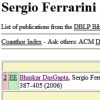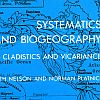| |
|
| |
   
Bhaskar DasGupta,
Sergio Ferrarini,
Uthra Gopalakrishnan and
Nisha Raj Paryani. Inapproximability results for the lateral gene transfer problem. In JCO, Vol. 11(4):387-405, 2006.
Keywords: approximation, from rooted trees, from species tree, inapproximability, lateral gene transfer, parsimony, phylogenetic network, phylogeny.
Note: http://www.cs.uic.edu/~dasgupta/resume/publ/papers/t-scenario-3-reviewed-3.pdf.
|
|
| |
|
| |
 
Roderic D.M. Page and
Michael A. Charleston. Trees within trees: phylogeny and historical associations. In TEE, Vol. 13(9):356-359, 1998.
Keywords: duplication, explicit network, from rooted trees, from species tree, lateral gene transfer, phylogenetic network, phylogeny, reconstruction, survey.
Note: http://taxonomy.zoology.gla.ac.uk/rod/papers/tree.pdf.
|
|
| |
   
Cuong Than,
Derek Ruths,
Hideki Innan and
Luay Nakhleh. Confounding Factors in HGT Detection: Statistical Error, Coalescent Effects, and Multiple Solutions. In JCB, Vol. 14(4):517-535, 2007.
Keywords: counting, explicit network, from rooted trees, from species tree, lateral gene transfer, phylogenetic network, phylogeny, Program LatTrans, Program PhyloNet.
Note: http://www.cs.rice.edu/~nakhleh/Papers/recombcg06-jcb.pdf.
|
|
| |
|
| |
|
| |
|
| |
|
| |
  
Tal Dagan,
Yael Artzy-Randrup and
William Martin. Modular networks and cumulative impact of lateral transfer in prokaryote genome evolution. In PNAS, Vol. 105:10039-10044, 2008.
Keywords: from sequences, from species tree, heuristic, lateral gene transfer, phylogenetic network, phylogeny, reconstruction.
Note: http://dx.doi.org/10.1073/pnas.0800679105.
Toggle abstract
"Lateral gene transfer is an important mechanism of natural variation among prokaryotes, but the significance of its quantitative contribution to genome evolution is debated. Here, we report networks that capture both vertical and lateral components of evolutionary history among 539,723 genes distributed across 181 sequenced prokaryotic genomes. Partitioning of these networks by an eigenspectrum analysis identifies community structure in prokaryotic gene-sharing networks, the modules of which do not correspond to a strictly hierarchical prokaryotic classification. Our results indicate that, on average, at least 81 ± 15% of the genes in each genome studied were involved in lateral gene transfer at some point in their history, even though they can be vertically inherited after acquisition, uncovering a substantial cumulative effect of lateral gene transfer on longer evolutionary time scales. © 2008 by The National Academy of Sciences of the USA."
|
|
| |
  
Ali Tofigh,
Mike Hallett and
Jens Lagergren. Simultaneous Identification of Duplications and Lateral Gene Transfers. In TCBB, Vol. 8(2):517-535, 2011.
Keywords: duplication, explicit network, FPT, from rooted trees, from species tree, lateral gene transfer, loss, NP complete, phylogenetic network, phylogeny, reconstruction.
Note: http://dx.doi.org/10.1109/TCBB.2010.14.
Toggle abstract
"The incongruency between a gene tree and a corresponding species tree can be attributed to evolutionary events such as gene duplication and gene loss. This paper describes a combinatorial model where so-called DTL-scenarios are used to explain the differences between a gene tree and a corresponding species tree taking into account gene duplications, gene losses, and lateral gene transfers (also known as horizontal gene transfers). The reasonable biological constraint that a lateral gene transfer may only occur between contemporary species leads to the notion of acyclic DTL-scenarios. Parsimony methods are introduced by defining appropriate optimization problems. We show that finding most parsimonious acyclic DTL-scenarios is NP-hard. However, by dropping the condition of acyclicity, the problem becomes tractable, and we provide a dynamic programming algorithm as well as a fixed-parameter tractable algorithm for finding most parsimonious DTL-scenarios. © 2011 IEEE."
|
|
| |
   
Sophie Abby,
Eric Tannier,
Manolo Gouy and
Vincent Daubin. Detecting lateral gene transfers by statistical reconciliation of phylogenetic forests. In BMCB, Vol. 11:324, 2010.
Keywords: agreement forest, explicit network, from rooted trees, from species tree, heuristic, lateral gene transfer, phylogenetic network, phylogeny, Program EEEP, Program PhyloNet, Program Prunier, reconstruction, software.
Note: http://www.biomedcentral.com/1471-2105/11/324.
Toggle abstract
"Background: To understand the evolutionary role of Lateral Gene Transfer (LGT), accurate methods are needed to identify transferred genes and infer their timing of acquisition. Phylogenetic methods are particularly promising for this purpose, but the reconciliation of a gene tree with a reference (species) tree is computationally hard. In addition, the application of these methods to real data raises the problem of sorting out real and artifactual phylogenetic conflict.Results: We present Prunier, a new method for phylogenetic detection of LGT based on the search for a maximum statistical agreement forest (MSAF) between a gene tree and a reference tree. The program is flexible as it can use any definition of "agreement" among trees. We evaluate the performance of Prunier and two other programs (EEEP and RIATA-HGT) for their ability to detect transferred genes in realistic simulations where gene trees are reconstructed from sequences. Prunier proposes a single scenario that compares to the other methods in terms of sensitivity, but shows higher specificity. We show that LGT scenarios carry a strong signal about the position of the root of the species tree and could be used to identify the direction of evolutionary time on the species tree. We use Prunier on a biological dataset of 23 universal proteins and discuss their suitability for inferring the tree of life.Conclusions: The ability of Prunier to take into account branch support in the process of reconciliation allows a gain in complexity, in comparison to EEEP, and in accuracy in comparison to RIATA-HGT. Prunier's greedy algorithm proposes a single scenario of LGT for a gene family, but its quality always compares to the best solutions provided by the other algorithms. When the root position is uncertain in the species tree, Prunier is able to infer a scenario per root at a limited additional computational cost and can easily run on large datasets.Prunier is implemented in C++, using the Bio++ library and the phylogeny program Treefinder. It is available at: http://pbil.univ-lyon1.fr/software/prunier. © 2010 Abby et al; licensee BioMed Central Ltd."
|
|
| |

Laura S. Kubatko. Identifying Hybridization Events in the Presence of Coalescence via Model Selection. In Systematic Biology, Vol. 58(5):478-488, 2009.
Keywords: AIC, BIC, branch length, coalescent, explicit network, from rooted trees, from species tree, hybridization, lineage sorting, model selection, phylogenetic network, phylogeny, statistical model.
Note: http://dx.doi.org/10.1093/sysbio/syp055.
|
|
| |
 
Lawrence A. David and
Eric J. Alm. Rapid evolutionary innovation during an Archaean genetic expansion. In Nature, Vol. 469:93-96, 2011.
Keywords: duplication, dynamic programming, from multilabeled tree, from rooted trees, from species tree, parsimony, phylogenetic network, phylogeny, Program Angst.
Note: http://dx.doi.org/10.1038/nature09649, Program Angst described here.
|
|
| |
   
Mukul S. Bansal,
Guy Banay,
J. Peter Gogarten and
Ron Shamir. Detecting Highways of Horizontal Gene Transfer. In JCB, Vol. 18(9):1087-1114, 2011.
Keywords: explicit network, from rooted trees, from species tree, lateral gene transfer, phylogenetic network, phylogeny, polynomial, reconstruction.
Note: http://people.csail.mit.edu/mukul/HighwayFull_preprint.pdf.
Toggle abstract
"In a horizontal gene transfer (HGT) event, a gene is transferred between two species that do not have an ancestor-descendant relationship. Typically, no more than a few genes are horizontally transferred between any two species. However, several studies identified pairs of species between which many different genes were horizontally transferred. Such a pair is said to be linked by a highway of gene sharing. We present a method for inferring such highways. Our method is based on the fact that the evolutionary histories of horizontally transferred genes disagree with the corresponding species phylogeny. Specifically, given a set of gene trees and a trusted rooted species tree, each gene tree is first decomposed into its constituent quartet trees and the quartets that are inconsistent with the species tree are identified. Our method finds a pair of species such that a highway between them explains the largest (normalized) fraction of inconsistent quartets. For a problem on n species and m input quartet trees, we give an efficient O(m+n 2)-time algorithm for detecting highways, which is optimal with respect to the quartets input size. An application of our method to a dataset of 1128 genes from 11 cyanobacterial species, as well as to simulated datasets, illustrates the efficacy of our method. © 2011, Mary Ann Liebert, Inc."
|
|
| |

Simon Joly. JML: Testing hybridization from species trees. In Molecular Ecology Ressources, Vol. 12(1):179-184, 2012.
Keywords: from species tree, hybridization, lineage sorting, phylogenetic network, phylogeny, Program JML, statistical model.
Note: http://www.plantevolution.org/pdf/JMLpaper_accepted.pdf.
Toggle abstract
"I introduce the software jml that tests for the presence of hybridization in multispecies sequence data sets by posterior predictive checking following Joly, McLenachan and Lockhart (2009, American Naturalist e54). Although their method could potentially be applied on any data set, the lack of appropriate software made its application difficult. The software jml thus fills a need for an easy application of the method but also includes improvements such as the possibility to incorporate uncertainty in the species tree topology. The jml software uses a posterior distribution of species trees, population sizes and branch lengths to simulate replicate sequence data sets using the coalescent with no migration. A test quantity, defined as the minimum pairwise sequence distance between sequences of two species, is then evaluated on the simulated data sets and compared to the one estimated from the original data. Because the test quantity is a good predictor of hybridization events, departure from the bifurcating species tree model could be interpreted as evidence of hybridization. Software performance in terms of computing time is evaluated for several parameters. I also show an application example of the software for detecting hybridization among native diploid North American roses. © 2011 Blackwell Publishing Ltd."
|
|
| |
  
Alix Boc,
Alpha B. Diallo and
Vladimir Makarenkov. T-REX: a web server for inferring, validating and visualizing phylogenetic trees and networks. In NAR, Vol. 40(W1):W573-W579, 2012.
Keywords: from rooted trees, from species tree, lateral gene transfer, phylogenetic network, phylogeny, Program T REX, reconstruction, reticulogram, software.
Note: http://dx.doi.org/10.1093/nar/gks485.
Toggle abstract
"T-REX (Tree and reticulogram REConstruction) is a web server dedicated to the reconstruction of phylogenetic trees, reticulation networks and to the inference of horizontal gene transfer (HGT) events. T-REX includes several popular bioinformatics applications such as MUSCLE, MAFFT, Neighbor Joining, NINJA, BioNJ, PhyML, RAxML, random phylogenetic tree generator and some well-known sequence-to-distance transformation models. It also comprises fast and effective methods for inferring phylogenetic trees from complete and incomplete distance matrices as well as for reconstructing reticulograms and HGT networks, including the detection and validation of complete and partial gene transfers, inference of consensus HGT scenarios and interactive HGT identification, developed by the authors. The included methods allows for validating and visualizing phylogenetic trees and networks which can be built from distance or sequence data. The web server is available at: www.trex.uqam.ca. © 2012 The Author(s)."
|
|
| |
    
Mukul S. Bansal,
Guy Banay,
Timothy J. Harlow,
J. Peter Gogarten and
Ron Shamir. Systematic inference of highways of horizontal gene transfer in prokaryotes. In BIO, Vol. 29(5):571-579, 2013.
Keywords: duplication, explicit network, from species tree, from unrooted trees, lateral gene transfer, phylogenetic network, phylogeny, Program HiDe, Program RANGER-DTL, reconstruction.
Note: http://people.csail.mit.edu/mukul/Bansal_Highways_Bioinformatics_2013.pdf.
|
|
| |
  
Celine Scornavacca,
Paprotny Wojciech,
Vincent Berry and
Vincent Ranwez. Representing a set of reconciliations in a compact way. In JBCB, Vol. 11(2):1250025, 2013.
Keywords: duplication, explicit network, from network, from rooted trees, from species tree, phylogeny, Program GraphDTL, Program TERA, visualization.
Note: http://hal-lirmm.ccsd.cnrs.fr/lirmm-00818801.
Toggle abstract
"Comparative genomic studies are often conducted by reconciliation analyses comparing gene and species trees. One of the issues with reconciliation approaches is that an exponential number of optimal scenarios is possible. The resulting complexity is masked by the fact that a majority of reconciliation software pick up a random optimal solution that is returned to the end-user. However, the alternative solutions should not be ignored since they tell different stories that parsimony considers as viable as the output solution. In this paper, we describe a polynomial space and time algorithm to build a minimum reconciliation graph-a graph that summarizes the set of all most parsimonious reconciliations. Amongst numerous applications, it is shown how this graph allows counting the number of non-equivalent most parsimonious reconciliations. © 2013 Imperial College Press."
|
|
| |

Luay Nakhleh. Computational approaches to species phylogeny inference and gene tree reconciliation. In Trends in Ecology and Evolution, Vol. 28(12):719-728, 2013.
Keywords: from rooted trees, from species tree, phylogenetic network, phylogeny, reconstruction, survey.
Note: http://bioinfo.cs.rice.edu/sites/bioinfo.cs.rice.edu/files/TREE-Nakhleh13.pdf.
Toggle abstract
"An intricate relation exists between gene trees and species phylogenies, due to evolutionary processes that act on the genes within and across the branches of the species phylogeny. From an analytical perspective, gene trees serve as character states for inferring accurate species phylogenies, and species phylogenies serve as a backdrop against which gene trees are contrasted for elucidating evolutionary processes and parameters. In a 1997 paper, Maddison discussed this relation, reviewed the signatures left by three major evolutionary processes on the gene trees, and surveyed parsimony and likelihood criteria for utilizing these signatures to elucidate computationally this relation. Here, I review progress that has been made in developing computational methods for analyses under these two criteria, and survey remaining challenges. © 2013 Elsevier Ltd."
|
|
| |
   
Thi-Hau Nguyen,
Vincent Ranwez,
Vincent Berry and
Celine Scornavacca. Support Measures to Estimate the Reliability of Evolutionary Events Predicted by Reconciliation Methods. In PLoS ONE, Vol. 8(10):e73667, 2013.
Keywords: duplication, from rooted trees, from species tree, phylogenetic network, phylogeny, polynomial, Program GraphDTL, reconstruction.
Note: http://dx.doi.org/10.1371/journal.pone.0073667.
Toggle abstract
"The genome content of extant species is derived from that of ancestral genomes, distorted by evolutionary events such as gene duplications, transfers and losses. Reconciliation methods aim at recovering such events and at localizing them in the species history, by comparing gene family trees to species trees. These methods play an important role in studying genome evolution as well as in inferring orthology relationships. A major issue with reconciliation methods is that the reliability of predicted evolutionary events may be questioned for various reasons: Firstly, there may be multiple equally optimal reconciliations for a given species tree-gene tree pair. Secondly, reconciliation methods can be misled by inaccurate gene or species trees. Thirdly, predicted events may fluctuate with method parameters such as the cost or rate of elementary events. For all of these reasons, confidence values for predicted evolutionary events are sorely needed. It was recently suggested that the frequency of each event in the set of all optimal reconciliations could be used as a support measure. We put this proposition to the test here and also consider a variant where the support measure is obtained by additionally accounting for suboptimal reconciliations. Experiments on simulated data show the relevance of event supports computed by both methods, while resorting to suboptimal sampling was shown to be more effective. Unfortunately, we also show that, unlike the majority-rule consensus tree for phylogenies, there is no guarantee that a single reconciliation can contain all events having above 50% support. In this paper, we detail how to rely on the reconciliation graph to efficiently identify the median reconciliation. Such median reconciliation can be found in polynomial time within the potentially exponential set of most parsimonious reconciliations. © 2013 Nguyen et al."
|
|
| |
  
Mukul S. Bansal,
Eric J. Alm and
Manolis Kellis. Reconciliation Revisited: Handling Multiple Optima when Reconciling with Duplication, Transfer, and Loss. In JCB, Vol. 20(10):738-754, 2013.
Keywords: duplication, from rooted trees, from species tree, loss, phylogenetic network, phylogeny, Program RANGER-DTL, reconstruction.
Note: http://www.engr.uconn.edu/~mukul/Bansal_JCB2013.pdf.
Toggle abstract
"Phylogenetic tree reconciliation is a powerful approach for inferring evolutionary events like gene duplication, horizontal gene transfer, and gene loss, which are fundamental to our understanding of molecular evolution. While duplication-loss (DL) reconciliation leads to a unique maximum-parsimony solution, duplication-transfer-loss (DTL) reconciliation yields a multitude of optimal solutions, making it difficult to infer the true evolutionary history of the gene family. This problem is further exacerbated by the fact that different event cost assignments yield different sets of optimal reconciliations. Here, we present an effective, efficient, and scalable method for dealing with these fundamental problems in DTL reconciliation. Our approach works by sampling the space of optimal reconciliations uniformly at random and aggregating the results. We show that even gene trees with only a few dozen genes often have millions of optimal reconciliations and present an algorithm to efficiently sample the space of optimal reconciliations uniformly at random in O(mn 2) time per sample, where m and n denote the number of genes and species, respectively. We use these samples to understand how different optimal reconciliations vary in their node mappings and event assignments and to investigate the impact of varying event costs. We apply our method to a biological dataset of approximately 4700 gene trees from 100 taxa and observe that 93% of event assignments and 73% of mappings remain consistent across different multiple optima. Our analysis represents the first systematic investigation of the space of optimal DTL reconciliations and has many important implications for the study of gene family evolution. © 2013 Mary Ann Liebert, Inc."
|
|
| |
  
Mehdi Layeghifard,
Pedro R. Peres-Neto and
Vladimir Makarenkov. Inferring explicit weighted consensus networks to represent alternative evolutionary histories. In BMCEB, Vol. 13(274):1-25, 2013.
Keywords: explicit network, from rooted trees, from species tree, phylogenetic network, phylogeny, Program ConsensusNetwork, reconstruction.
Note: http://dx.doi.org/10.1186/1471-2148-13-274.
Toggle abstract
"Background: The advent of molecular biology techniques and constant increase in availability of genetic material have triggered the development of many phylogenetic tree inference methods. However, several reticulate evolution processes, such as horizontal gene transfer and hybridization, have been shown to blur the species evolutionary history by causing discordance among phylogenies inferred from different genes. Methods. To tackle this problem, we hereby describe a new method for inferring and representing alternative (reticulate) evolutionary histories of species as an explicit weighted consensus network which can be constructed from a collection of gene trees with or without prior knowledge of the species phylogeny. Results: We provide a way of building a weighted phylogenetic network for each of the following reticulation mechanisms: diploid hybridization, intragenic recombination and complete or partial horizontal gene transfer. We successfully tested our method on some synthetic and real datasets to infer the above-mentioned evolutionary events which may have influenced the evolution of many species. Conclusions: Our weighted consensus network inference method allows one to infer, visualize and validate statistically major conflicting signals induced by the mechanisms of reticulate evolution. The results provided by the new method can be used to represent the inferred conflicting signals by means of explicit and easy-to-interpret phylogenetic networks. © 2013 Layeghifard et al.; licensee BioMed Central Ltd."
|
|
| |
  
Zhi-Zhong Chen,
Fei Deng and
Lusheng Wang. Simultaneous Identification of Duplications, Losses, and Lateral Gene Transfers. In TCBB, Vol. 9(5):1515-1528, 2012.
Keywords: duplication, explicit network, FPT, from rooted trees, from species tree, lateral gene transfer, loss, phylogenetic network, phylogeny, reconstruction.
Note: http://www.cs.cityu.edu.hk/~lwang/research/tcbb2012c.pdf.
Toggle abstract
"We give a fixed-parameter algorithm for the problem of enumerating all minimum-cost LCA-reconciliations involving gene duplications, gene losses, and lateral gene transfers (LGTs) for a given species tree S and a given gene tree G. Our algorithm can work for the weighted version of the problem, where the costs of a gene duplication, a gene loss, and an LGT are left to the user's discretion. The algorithm runs in O(m+3 k/c n) time, where m is the number of vertices in S, n is the number of vertices in G, c is the smaller between a gene duplication cost and an LGT cost, and k is the minimum cost of an LCA-reconciliation between S and G. The time complexity is indeed better if the cost of a gene loss is greater than 0. In particular, when the cost of a gene loss is at least 0.614c, the running time of the algorithm is O(m+2.78 k/cn). © 2004-2012 IEEE."
|
|
| |
     
Joel Sjöstrand,
Ali Tofigh,
Vincent Daubin,
Lars Arvestad,
Bengt Sennblad and
Jens Lagergren. A Bayesian Method for Analyzing Lateral Gene Transfer. In Systematic Biology, Vol. 63(3):409-420, 2014.
Keywords: bayesian, duplication, from rooted trees, from sequences, from species tree, lateral gene transfer, loss, phylogenetic network, phylogeny, Program JPrIME-DLTRS, reconstruction.
Note: http://dx.doi.org/10.1093/sysbio/syu007.
|
|
| |
   
Vincent Ranwez,
Celine Scornavacca,
Jean-Philippe Doyon and
Vincent Berry. Inferring gene duplications, transfers and losses can be done in a discrete framework. In JOMB, Vol. 72(7):1811-1844, 2016.
Keywords: duplication, explicit network, from rooted trees, from species tree, lateral gene transfer, loss, phylogenetic network, phylogeny, reconstruction.
|
|
| |
    
François Chevenet,
Jean-Philippe Doyon,
Celine Scornavacca,
Edwin Jacox,
Emmanuelle Jousselin and
Vincent Berry. SylvX: a viewer for phylogenetic tree reconciliations. In BIO, Vol. 32(4):608-610, 2016.
Keywords: duplication, explicit network, from rooted trees, from species tree, lateral gene transfer, loss, phylogenetic network, phylogeny, Program SylvX, software, visualization.
Note: https://www.researchgate.net/profile/Emmanuelle_Jousselin/publication/283446016_SylvX_a_viewer_for_phylogenetic_tree_reconciliations/links/5642146108aec448fa621efa.pdf.
|
|
| |
 
Misagh Kordi and
Mukul S. Bansal. On the Complexity of Duplication-Transfer-Loss Reconciliation with Non-Binary Gene Trees. In TCBB, Vol. 14(3):587-599, 2017.
Keywords: duplication, from rooted trees, from species tree, lateral gene transfer, loss, NP complete, phylogenetic network, phylogeny, reconstruction.
Note: http://compbio.engr.uconn.edu/papers/Kordi_DTLreconciliationPreprint2015.pdf.
|
|
| |
  
Edwin Jacox,
Cédric Chauve,
Gergely J. Szöllösi,
Yann Ponty and
Celine Scornavacca. EcceTERA: comprehensive gene tree-species tree reconciliation using parsimony. In BIO, Vol. 32(13):2056-2058, 2016.
Keywords: duplication, explicit network, from rooted trees, from species tree, lateral gene transfer, loss, parsimony, phylogenetic network, phylogeny, polynomial, Program ecceTERA.
Note: https://doi.org/10.1093/bioinformatics/btw105.
|
|
| |
   
Edwin Jacox,
Mathias Weller,
Eric Tannier and
Celine Scornavacca. Resolution and reconciliation of non-binary gene trees with transfers, duplications and losses. In BIO, Vol. 33(7):980-987, 2017.
Keywords: duplication, explicit network, FPT, from rooted trees, from species tree, lateral gene transfer, loss, phylogenetic network, phylogeny, reconstruction.
Note: http://dx.doi.org/10.1093/bioinformatics/btw778.
|
|
|
|
| |
|
| |
|
| |
   
Cuong Than,
Derek Ruths,
Hideki Innan and
Luay Nakhleh. Identifiability Issues in Phylogeny-Based Detection of Horizontal Gene Transfer. In Proceedings of the Fourth RECOMB Comparative Genomics Satellite Workshop (RECOMB-CG'06), Vol. 4205:215-229 of LNCS, springer, 2006.
Keywords: explicit network, from rooted trees, from species tree, lateral gene transfer, phylogenetic network, phylogeny, Program LatTrans, Program PhyloNet.
Note: http://www.cs.rice.edu/~nakhleh/Papers/recombcg06-final.pdf.
|
|
| |
|
| |
   
Bhaskar DasGupta,
Sergio Ferrarini,
Uthra Gopalakrishnan and
Nisha Raj Paryani. Inapproximability results for the lateral gene transfer problem. In Proceedings of the Ninth Italian Conference on Theoretical Computer Science (ICTCS'05), Pages 182-195, springer, 2005.
Keywords: approximation, from rooted trees, from species tree, inapproximability, lateral gene transfer, parsimony, phylogenetic network, phylogeny.
Note: http://www.cs.uic.edu/~dasgupta/resume/publ/papers/ictcs-final.pdf.
|
|
| |
  
Mike Hallett,
Jens Lagergren and
Ali Tofigh. Simultaneous Identification of Duplications and Lateral Transfers. In RECOMB04, Pages 347-356, 2004.
Keywords: duplication, explicit network, FPT, from rooted trees, from species tree, lateral gene transfer, loss, NP complete, parsimony, phylogenetic network, phylogeny, polynomial, reconstruction.
Note: http://www.nada.kth.se/~jensl/p164-hallett.pdf.
|
|
| |

Pawel Górecki. Reconciliation problems for duplication, loss and horizontal gene transfer. In RECOMB04, Pages 316-325, 2004.
Keywords: duplication, explicit network, from rooted trees, from species tree, lateral gene transfer, loss, NP complete, parsimony, phylogenetic network, phylogeny, polynomial, reconstruction.
Note: http://ai.stanford.edu/~serafim/CS374_2004/Papers/Gorecki_Reconciliation.pdf.
|
|
| |

Pawel Górecki. Single step reconciliation algorithm for duplication, loss and horizontal gene transfer model. In ECCB03, 2003.
Keywords: duplication, explicit network, from rooted trees, from species tree, lateral gene transfer, NP complete, parsimony, phylogenetic network, phylogeny, polynomial, reconstruction.
Note: http://www.inra.fr/eccb2003/posters/pdf/short/S_gorecki.ps.
|
|
| |
|
| |
|
| |
    
Jean-Philippe Doyon,
Celine Scornavacca,
Konstantin Yu Gorbunov,
Gergely J. Szöllösi,
Vincent Ranwez and
Vincent Berry. An efficient algorithm for gene/species trees parsimonious reconciliation with losses, duplications, and transfers. In Proceedings of the Eighth RECOMB Comparative Genomics Satellite Workshop (RECOMB-CG'10), Vol. 6398:93-108 of LNCS, springer, 2011.
Keywords: branch length, duplication, dynamic programming, explicit network, from multilabeled tree, from species tree, from unrooted trees, lateral gene transfer, loss, phylogenetic network, phylogeny, polynomial, Program Mowgli, reconstruction.
Note: http://www.lirmm.fr/~vberry/Publis/MPR-DoyonEtAl.pdf, software available at http://www.atgc-montpellier.fr/MPR/.
Toggle abstract
"Tree reconciliation methods aim at estimating the evolutionary events that cause discrepancy between gene trees and species trees. We provide a discrete computational model that considers duplications, transfers and losses of genes. The model yields a fast and exact algorithm to infer time consistent and most parsimonious reconciliations. Then we study the conditions under which parsimony is able to accurately infer such events. Overall, it performs well even under realistic rates, transfers being in general less accurately recovered than duplications. An implementation is freely available at http://www.atgc- montpellier.fr/MPR. © 2010 Springer-Verlag."
|
|
| |
  
Mukul S. Bansal,
J. Peter Gogarten and
Ron Shamir. Detecting Highways of Horizontal Gene Transfer. In Proceedings of the Eighth RECOMB Comparative Genomics Satellite Workshop (RECOMB-CG'10), Vol. 6398:109-120 of LNCS, springer, 2011.
Keywords: explicit network, from rooted trees, from species tree, lateral gene transfer, phylogenetic network, phylogeny, polynomial, reconstruction.
Note: http://www.cs.iastate.edu/~bansal/Highways_RCG10.pdf.
Toggle abstract
"In a horizontal gene transfer (HGT) event a gene is transferred between two species that do not share an ancestor-descendant relationship. Typically, no more than a few genes are horizontally transferred between any two species. However, several studies identified pairs of species between which many different genes were horizontally transferred. Such a pair is said to be linked by a highway of gene sharing. We present a method for inferring such highways. Our method is based on the fact that the evolutionary histories of horizontally transferred genes disagree with the corresponding species phylogeny. Specifically, given a set of gene trees and a trusted rooted species tree, each gene tree is first decomposed into its constituent quartet trees and the quartets that are inconsistent with the species tree are identified. Our method finds a pair of species such that a highway between them explains the largest (normalized) fraction of inconsistent quartets. For a problem on n species, our method requires O(n 4) time, which is optimal with respect to the quartets input size. An application of our method to a dataset of 1128 genes from 11 cyanobacterial species, as well as to simulated datasets, illustrates the efficacy of our method. © 2010 Springer-Verlag."
|
|
| |
  
Mukul S. Bansal,
Eric J. Alm and
Manolis Kellis. Efficient Algorithms for the Reconciliation Problem with Gene Duplication, Horizontal Transfer, and Loss. In ISMB12, Vol. 28(12):i283-i291 of BIO, 2012.
Keywords: duplication, explicit network, from rooted trees, from species tree, lateral gene transfer, loss, phylogenetic network, phylogeny, Program Angst, Program Mowgli, Program RANGER-DTL, reconstruction.
Note: http://dx.doi.org/10.1093/bioinformatics/bts225.
Toggle abstract
"Motivation: Gene family evolution is driven by evolutionary events such as speciation, gene duplication, horizontal gene transfer and gene loss, and inferring these events in the evolutionary history of a given gene family is a fundamental problem in comparative and evolutionary genomics with numerous important applications. Solving this problem requires the use of a reconciliation framework, where the input consists of a gene family phylogeny and the corresponding species phylogeny, and the goal is to reconcile the two by postulating speciation, gene duplication, horizontal gene transfer and gene loss events. This reconciliation problem is referred to as duplication-transfer-loss (DTL) reconciliation and has been extensively studied in the literature. Yet, even the fastest existing algorithms for DTL reconciliation are too slow for reconciling large gene families and for use in more sophisticated applications such as gene tree or species tree reconstruction.Results: We present two new algorithms for the DTL reconciliation problem that are dramatically faster than existing algorithms, both asymptotically and in practice. We also extend the standard DTL reconciliation model by considering distance-dependent transfer costs, which allow for more accurate reconciliation and give an efficient algorithm for DTL reconciliation under this extended model. We implemented our new algorithms and demonstrated up to 100 000-fold speed-up over existing methods, using both simulated and biological datasets. This dramatic improvement makes it possible to use DTL reconciliation for performing rigorous evolutionary analyses of large gene families and enables its use in advanced reconciliation-based gene and species tree reconstruction methods. © The Author(s) 2012. Published by Oxford University Press."
|
|
| |
  
Mukul S. Bansal,
Eric J. Alm and
Manolis Kellis. Reconciliation Revisited: Handling Multiple Optima when Reconciling with Duplication, Transfer, and Loss. In RECOMB13, Vol. 7821:1-13 of LNCS, springer, 2013.
Keywords: duplication, from rooted trees, from species tree, loss, phylogenetic network, phylogeny, polynomial, Program RANGER-DTL, reconstruction.
Note: http://people.csail.mit.edu/mukul/Bansal_RECOMB2013.pdf.
Toggle abstract
"Phylogenetic tree reconciliation is a powerful approach for inferring evolutionary events like gene duplication, horizontal gene transfer, and gene loss, which are fundamental to our understanding of molecular evolution. While Duplication-Loss (DL) reconciliation leads to a unique maximum-parsimony solution, Duplication-Transfer-Loss (DTL) reconciliation yields a multitude of optimal solutions, making it difficult the infer the true evolutionary history of the gene family. Here, we present an effective, efficient, and scalable method for dealing with this fundamental problem in DTL reconciliation. Our approach works by sampling the space of optimal reconciliations uniformly at random and aggregating the results. We present an algorithm to efficiently sample the space of optimal reconciliations uniformly at random in O(mn 2) time, where m and n denote the number of genes and species, respectively. We use these samples to understand how different optimal reconciliations vary in their node mapping and event assignments, and to investigate the impact of varying event costs. © 2013 Springer-Verlag."
|
|
| |
|
| |
   
Louxin Zhang,
Yen Kaow Ng,
Taoyang Wu and
Yu Zheng. Network model and efficient method for detecting relative duplications or horizontal gene transfers. In ICCABS11, Pages 214-219, 2011.
Keywords: dynamic programming, explicit network, from network, from rooted trees, from species tree, phylogenetic network, phylogeny, polynomial, reconstruction.
Toggle abstract
"Background: Horizontal gene transfer and gene duplication are two significant forces behind genome evolution. As more and more well-supported examples of HGTs are being revealed, there is a growing awareness that HGT is more widespread than previously thought, occurring often not only within bacteria, but also between species remotely related such as bacteria and plants or plants and animals. Although a substantial number of genomic sequences are known, HGT inference remains challenging. Parsimony-based inferences of HGT events are typically NP-hard under the framework of gene tree and species tree comparison; it is even more timeconsuming if the maximum likelihood approach is used. The fact that gene tree and species tree incongruence can be further confounded by gene duplication and gene loss events motivates us to incorporate considerations for these events into our inference of HGT events. Similarly, it will be beneficial if known HGT events are considered in the inference of gene duplications and gene losses. © 2011 IEEE."
|
|
| |
 
Misagh Kordi and
Mukul S. Bansal. On the Complexity of Duplication-Transfer-Loss Reconciliation with Non-Binary Gene Trees. In ISBRA15, Vol. 9096:187-198 of LNCS, springer, 2015.
Keywords: duplication, from rooted trees, from species tree, lateral gene transfer, loss, NP complete, phylogenetic network, phylogeny, reconstruction.
Note: http://compbio.engr.uconn.edu/papers/Kordi_ISBRA2015.pdf.
|
|
| |
  
Han Lai,
Maureen Stolzer and
Dannie Durand. Fast Heuristics for Resolving Weakly Supported Branches Using Duplication, Transfers, and Losses. In RECOMB-CG17, Vol. 10562:298-320 of LNCS, Springer, 2017.
Keywords: duplication, explicit network, from rooted trees, from species tree, lateral gene transfer, loss, phylogenetic network, phylogeny, Program Notung, reconstruction.
|
|
|
|
 - forked on GitHub.
- forked on GitHub.



































































